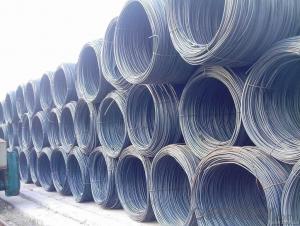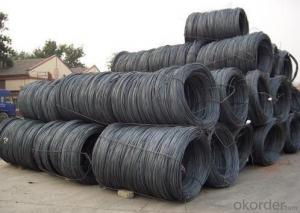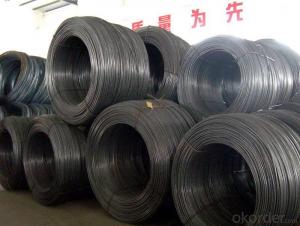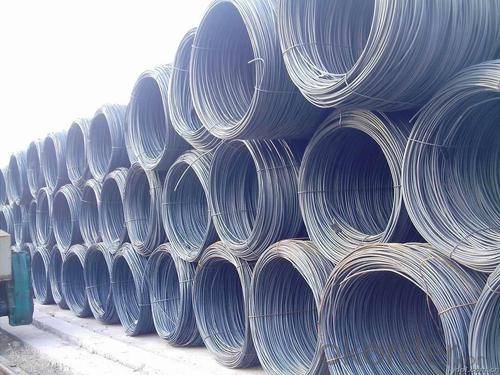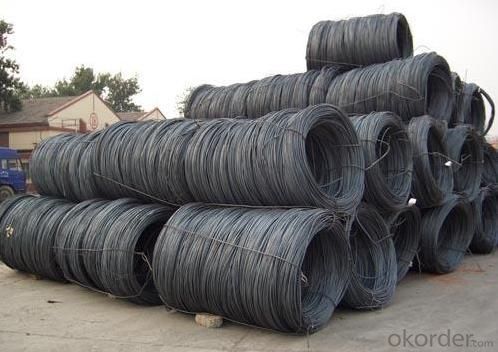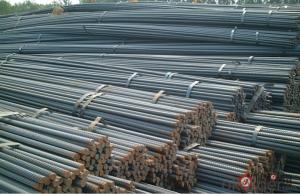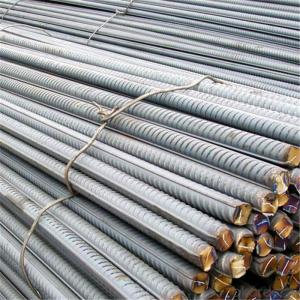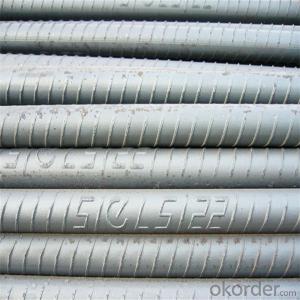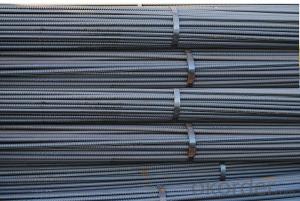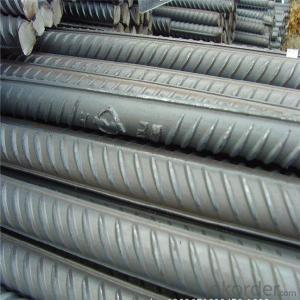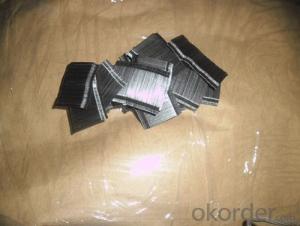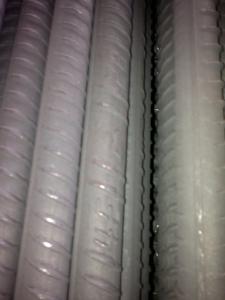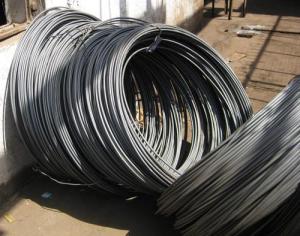Wire Rods Steel for Construction/ Concrete Usage
- Loading Port:
- Tianjin
- Payment Terms:
- TT or LC
- Min Order Qty:
- 28 m.t.
- Supply Capability:
- 40000 m.t./month
OKorder Service Pledge
OKorder Financial Service
You Might Also Like
Product Description:
OKorder is offering Wire Rods Steel for Construction/ Concrete Usage at great prices with worldwide shipping. Our supplier is a world-class manufacturer of steel, with our products utilized the world over. OKorder annually supplies products to European, North American and Asian markets. We provide quotations within 24 hours of receiving an inquiry and guarantee competitive prices.
Product Applications:
Wire Rods Steel for Construction/ Concrete Usage are ideal for structural applications and are widely used in the construction of buildings and bridges, and the manufacturing, petrochemical, and transportation industries.
Product Advantages:
OKorder's Wire Rods Steel for Construction/ Concrete Usage are durable, strong, and resist corrosion.
Main Product Features:
· Premium quality
· Prompt delivery & seaworthy packing (30 days after receiving deposit)
· Corrosion resistance
· Can be recycled and reused
· Mill test certification
· Professional Service
· Competitive pricing
Product Specifications:
wire rod:
Grade:SAE1006B/SAE1008B/SAE1018B
Size:5.5/6.5/7/8/9/10/11/12mm
wire rods are suitable for a wide range of applications such as : -
fasteners, bolts, rivets, screws,
general purpose wires,
electrode wires, industrial wires, agriculture wires,
bush wires, chain rivet wires,
detonator wire,
Umbrella ribs, upholstery wires, cycle spokes, needle wires, heald wires, staple pin Wire, safety pin wires
ACSR wires, earth wires,
tyre and hose reinforcement wires,
prestressed concrete wire, springs and rope wires,
card clothing wires,
vineyard wires,
ball bearing quality
Automobile parts like screw, fasteners, bush, spline, socket, connecting rod, shaft, gear, rivets, engine shaft, connecting rod, spindles, gears, etc.
FAQ:
Q1: Why buy Materials & Equipment from OKorder.com?
A1: All products offered byOKorder.com are carefully selected from China's most reliable manufacturing enterprises. Through its ISO certifications, OKorder.com adheres to the highest standards and a commitment to supply chain safety and customer satisfaction.
Q2: How do we guarantee the quality of our products?
A2: We have established an advanced quality management system which conducts strict quality tests at every step, from raw materials to the final product. At the same time, we provide extensive follow-up service assurances as required.
Q3: How soon can we receive the product after purchase?
A3: Within three days of placing an order, we will begin production. The specific shipping date is dependent upon international and government factors, but is typically 7 to 10 workdays.
Q4: What makes stainless steel stainless?
A4: Stainless steel must contain at least 10.5 % chromium. It is this element that reacts with the oxygen in the air to form a complex chrome-oxide surface layer that is invisible but strong enough to prevent further oxygen from "staining" (rusting) the surface. Higher levels of chromium and the addition of other alloying elements such as nickel and molybdenum enhance this surface layer and improve the corrosion resistance of the stainless material.
Q5: Can stainless steel rust?
A5: Stainless does not "rust" as you think of regular steel rusting with a red oxide on the surface that flakes off. If you see red rust it is probably due to some iron particles that have contaminated the surface of the stainless steel and it is these iron particles that are rusting. Look at the source of the rusting and see if you can remove it from the surface.

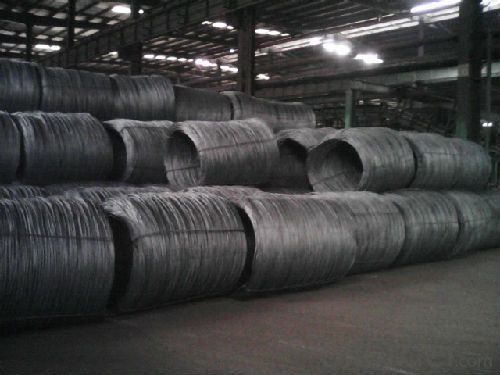
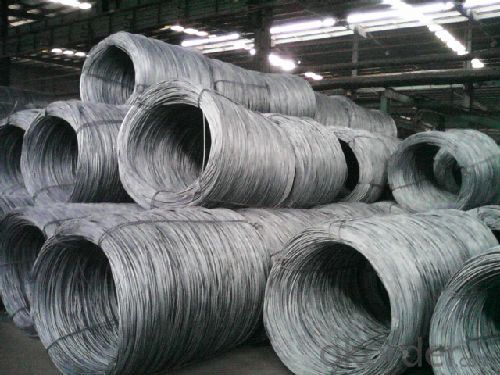
- Q: How is steel wire rod used in the production of wire mesh screens?
- Steel wire rod is used in the production of wire mesh screens as it serves as the primary material for creating the mesh itself. The wire rod is first drawn into the desired thickness and then woven or welded together to form the mesh pattern. This sturdy and durable steel wire rod ensures that the wire mesh screens can withstand various applications such as filtration, separation, and protection, making them ideal for use in industries like construction, mining, and agriculture.
- Q: What are the common welding techniques used for steel wire rod?
- The common welding techniques used for steel wire rod include gas metal arc welding (GMAW), flux-cored arc welding (FCAW), and submerged arc welding (SAW).
- Q: What are the advantages of using steel wire rod?
- There are several advantages of using steel wire rod. First, it has high strength and durability, making it suitable for various applications, including construction, manufacturing, and automotive industries. Second, steel wire rod has excellent flexibility, allowing it to be easily shaped and manipulated for different purposes. Third, it has good resistance to corrosion and can withstand harsh environmental conditions, ensuring long-lasting performance. Additionally, steel wire rod is recyclable, making it an eco-friendly choice compared to other materials.
- Q: What are the common applications of high carbon steel wire rod?
- Due to its distinct qualities, high carbon steel wire rod is widely used for various purposes. One prominent use is in the manufacturing of springs, which are commonly found in automotive suspension systems and industrial machinery. The wire rod's high carbon content gives it exceptional strength and durability, allowing it to endure the constant stress and tension experienced by springs. Another prevalent application is in the production of wire ropes and cables. High carbon steel wire rod is highly favored for this purpose due to its remarkable tensile strength, enabling it to bear heavy loads and resist deformation. Wire ropes and cables made from high carbon steel wire rod are extensively utilized in the construction, mining, and transportation industries. Piano wire manufacturing is another significant utilization of high carbon steel wire rod. The wire's high strength and outstanding resilience make it an ideal choice for producing piano strings that can withstand the tension and vibration needed to produce the desired musical notes. Moreover, high carbon steel wire rod is frequently employed in the production of wire mesh and wire fencing. Its strength and durability make it suitable for creating fences and enclosures that offer security and containment in diverse settings, including residential, agricultural, and industrial areas. In conclusion, high carbon steel wire rod is commonly used in the production of springs, wire ropes and cables, piano wire, and wire mesh or fencing. Its unique properties make it the preferred choice for these applications, providing strength, durability, and the ability to withstand tension and stress.
- Q: How is steel wire rod tested for resistance to erosion corrosion?
- Steel wire rod is tested for resistance to erosion corrosion through a combination of laboratory experiments and field trials. In the lab, samples of the wire rod are subjected to simulated erosion corrosion conditions, such as exposure to corrosive fluids or abrasive particles, to determine their resistance. These tests measure parameters like weight loss, surface roughness, and corrosion rate. Additionally, field trials are conducted by installing the wire rod in real-world environments where erosion corrosion is likely to occur, and monitoring its performance over an extended period. By combining these approaches, manufacturers can ensure that steel wire rod meets the required standards for resistance to erosion corrosion.
- Q: What are the different types of steel wire rod surface cleaning tools?
- There are several types of steel wire rod surface cleaning tools available, including wire brushes, sandpaper, abrasive wheels, and chemical cleaners. Each tool has its own unique advantages and suitability for different levels of cleaning and surface preparation.
- Q: What are the main factors affecting the availability of steel wire rod?
- The main factors affecting the availability of steel wire rod include the demand-supply dynamics in the market, fluctuations in raw material prices, production capacity of steel mills, global trade policies, and the overall economic conditions.
- Q: What are the different types of steel wire rod coatings used for electrical conductivity?
- The different types of steel wire rod coatings used for electrical conductivity include copper coating, zinc coating, tin coating, and silver coating.
- Q: How is steel wire rod used in the manufacturing of wire for mattress springs?
- Steel wire rod is used in the manufacturing of wire for mattress springs by being drawn through a series of dies to reduce its diameter to the desired thickness. This process, called wire drawing, helps in strengthening the wire and increases its tensile strength, making it suitable for use in mattress springs. The wire is then coiled and tempered to enhance its flexibility and durability, ensuring it can withstand repeated pressure and movement in the mattress.
- Q: What are the different types of steel wire rod drawing lubricants?
- There are several different types of steel wire rod drawing lubricants that are used in the wire manufacturing industry. These lubricants are essential for reducing friction and heat during the drawing process, ensuring smooth wire production. 1. Oil-based lubricants: These lubricants are made from petroleum-based oils and are commonly used in wire drawing operations. They provide good lubrication and cooling properties, reducing friction and heat generation during the drawing process. 2. Emulsion lubricants: Emulsion lubricants are a mixture of oil and water, which are commonly used as lubricants in wire drawing processes. They offer better cooling properties compared to oil-based lubricants and are suitable for high-speed wire drawing operations. 3. Synthetic lubricants: Synthetic lubricants are made from synthetic oils and provide excellent lubrication properties. They have a high viscosity index, which means they maintain their lubricating properties over a wide range of temperatures. Synthetic lubricants are commonly used in high-speed wire drawing operations. 4. Dry lubricants: Dry lubricants are in the form of powders or solid films that are applied to the wire surface. These lubricants provide excellent lubrication and are suitable for wire drawing operations where liquid lubricants may interfere with subsequent processes, such as plating. 5. Grease lubricants: Grease lubricants are semi-solid lubricants that are commonly used in wire drawing operations. They offer good lubrication properties and can be easily applied to the wire surface. It's important to note that the choice of lubricant depends on various factors, including the wire material, wire diameter, drawing speed, and other specific requirements of the wire drawing process. Therefore, it's essential to consult with lubricant suppliers or industry experts to determine the most suitable lubricant for a particular wire rod drawing operation.
Send your message to us
Wire Rods Steel for Construction/ Concrete Usage
- Loading Port:
- Tianjin
- Payment Terms:
- TT or LC
- Min Order Qty:
- 28 m.t.
- Supply Capability:
- 40000 m.t./month
OKorder Service Pledge
OKorder Financial Service
Similar products
Hot products
Hot Searches
Related keywords
